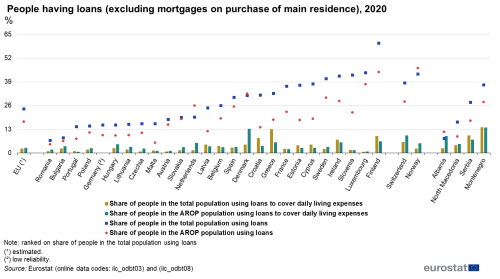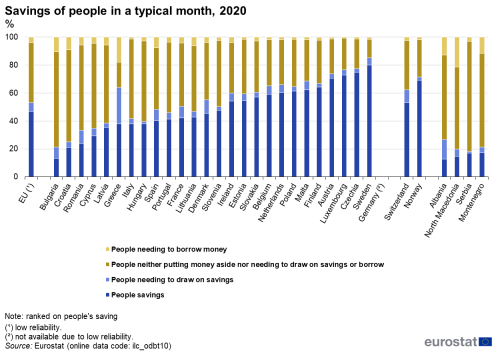Financial vulnerability in households
Data extracted in October 2023.
No planned article update.
Highlights
In 2020, 47 % of people in the EU could put aside some savings each month.
In 2020, 22 % of people in the EU were able to maintain the same standard of living for 3-6 months using only their savings.

Source: Eurostat (ilc_odbt03) and (ilc_odbt08)
This article analyses household financial vulnerability, presenting some key results from the EU statistics on income and living conditions (EU-SILC) 2020 ad-hoc module on over-indebtedness, consumption and wealth. Data are collected at household level and represent people living in private households. EU-SILC data are available for all EU Member States, as well as for most European Free Trade Association (EFTA) and candidate countries.
This article provides an overview of the distribution of loans according to the poverty status of the population, also focusing on people who have loans to cover daily living expenses. In addition, it sheds some light on saving habits and to what extent they help people maintain the same standard of living.
Full article
Key findings
In 2020:
- 46.9 % of people in the EU were able to save money in a typical month;
- 6.3 % needed to use their savings to cover living expenses and 3.9 % borrowed money;
- 42.9 % used their income to cover daily expenses and neither saved nor borrowed money.
Regarding savings, in 2020:
- 46.2 % of people in the EU were able to maintain the same standard of living for less than 3 months using only their savings;
- 22.3 % for 3-6 months;
- 16.1 % for 6-12 months; and
- 15.4 % for over 12 months.

Source: Eurostat (ilc_odbt03) and (ilc_odbt08)
In 2020, 24.1 % of the EU population took out loans (excluding mortgages for purchasing the main residence), with 10.1 % of these people (2.4 % of the EU population) using these loans to cover their daily living expenses. The countries with the highest proportions of their population with loans were Finland (60.2 %), Luxembourg (44.0 %) and Slovenia (42.7 %), while those with the lowest were Romania and Bulgaria, with 6.9 % and 8.2 %, respectively. For the EU population at risk of poverty (AROP), the share of people taking loans was 17.1 %. Some 16 % of these people (2.7 % of the EU population) borrowed money to cover their daily living expenses. Across EU countries, the highest shares of the AROP population that borrowed money to cover living expenses were in Denmark and Finland, 13.2 % and 6.4 %, respectively. The differences between general and AROP population figures, at EU and national level, might not only show the need for borrowing money but also accessibility of credit for those in need.
Ability to save in a typical month
In 2020, most people in the EU were, in a typical month, able to either save money (46.9 %) or to make ends meet (not saving but not drawing on savings or borrowing) (42.9 %). Only 6.3 % and 3.9% of people were obliged to use their savings or to borrow, respectively. In 2020, at national level, the proportion of people able to save money in a typical month varied across EU countries. The share of people with the highest level of ability to save in a typical month was recorded in Sweden (80.2 %), followed by Czechia (75.0 %), Luxembourg (72.9 %), Austria (70.6 %), Finland (64.4 %), Malta (62.2 %), Poland (61.5 %) and the Netherlands (60.4 %). On the other hand, the share of people with the lowest level of ability to save was recorded in Bulgaria (13.3 %), Croatia (21.0 %), Romania (23.8 %) and Cyprus (29.4 %). In addition, 6.3 % of people in the EU needed to use their savings to cover their daily living expenses in a typical month. The countries with the highest shares of the population using their savings to pay for living expenses were Greece (26.2 %), Romania and Denmark (both with a share of 9.7 %), and France (8.3 %), while the lowest share was reported in Hungary (1.8 %). Furthermore, 3.9 % of people in the EU borrowed money to cover their daily living expenses. Greece had the highest share of people borrowing (17.8 %), followed by Bulgaria (10.6 %) and Croatia (9.0 %), while the lowest shares were observed in Luxembourg (0.8 %), Italy (1.2 %), Austria (1.3 %) and Czechia (1.4 %).
Most people in the EU were able to maintain the same standard of living by using savings for less than 6 months

Source: Eurostat (ilc_odbt14)
In 2020, 46.2 % of people in the EU were able to maintain the same standard of living for less than 3 months using exclusively their savings, 22.3 % for 3-6 months, 16.1 % for 6-12 months, and 15.4 % for longer than 12 months. At national level, the following situation can be observed:
- For less than 3 months, the highest shares of population able to maintain the same standard of living were observed in Bulgaria (80.6 %), Romania (69.3 %) and Hungary (66.4 %). On the other hand, Austria (23.8 %), the Netherlands (24.1 %) and Malta (26.6 %) reported the lowest shares.
- For 3-6 months, the highest shares were observed in Slovakia (32.9 %), followed by Czechia (32.3 %), Lithuania (29.6 %), Poland (29.5 %) and Estonia (28.9 %), with the lowest in Bulgaria (14.3 %), Spain (17.2 %) and Romania (17.9 %).
- For 6-12 months, the highest shares were observed in Austria (27.8 %), Malta (26.4 %), Croatia (22.9 %) and Finland (22.1 %), while Bulgaria had the lowest (3.6 %).
- For more than 1 year, the highest shares were observed in the Netherlands (28.3 %), Sweden (26.3 %) and Belgium (25.7 %), while the lowest were observed in Bulgaria (1.5 %) and Romania (3.7 %).
Source data for tables and graphs
Data sources
The data used in this article are derived from the 2020 EU statistics on income and living conditions (EU-SILC) ad-hoc module on over-indebtedness, consumption and wealth.
The reference population for the information presented in this article is all private households and their current members residing in the territory of an EU Member State (or non-EU member country) at the time of data collection; persons living in collective households and in institutions are generally excluded from the target population. The data for the EU are population-weighted averages of national data. More information on the exact data collection periods in individual Member States can be found in the EU-SILC metadata file and national quality reports.
Context
Indicators calculated with data from the 2020 module on Over-indebtedness, consumption and wealth allow to obtain information on households’ economic hardship and debt situation. The excessive accumulation of debts, in fact, might lead households to a higher risk of poverty and social exclusion. To provide a comprehensive view of households’ financial situation, Eurostat also produced a number of indicators exploring their loans and savings practices by different income levels and risk of poverty thresholds.
Direct access to
Database
Dedicated section
- Income and living conditions (ESMS metadata file — ilc_esms)
- Income and living conditions — information on data
- Income and living conditions — methodology
